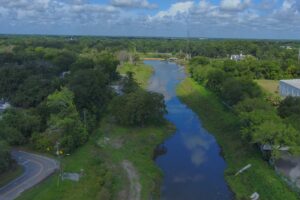District’s Moses Creek Conservation Area key to citizen-scientist’s studies
Steve Dennis studies killers.
In the oppressive sauna Floridians call summer, Dennis explores Moses Creek Conservation Area in coastal St. Johns County and studies assassin flies, otherwise known as robber flies.
Dennis is an authority on these aggressive, predatory flies. He tracks their daily rhythms. He knows their grooming habits, their favorite resting spots and even their favorite time of day to lay their eggs.
“I’ve been studying these flies in the conservation area for 10 years,” the St. Augustine resident says. “Robber flies get their name from their predatory trait of robbing other insects of their lives.”
To the uninitiated, studying flies may sound like a punchline to a joke. Certainly, fly-watching may not enjoy the widespread popularity of, say, birdwatching. However, Dennis’ description of an assassin fly in predatory mode is fascinating.
“Assassin flies perch on vegetation, the ground or rocks and look for insects flying by, attack their prey in midair and paralyze them with a neurotoxin and an enzyme (venomous saliva),” he says.
“Assassin flies feed on a variety of other insects, including beetles, butterflies, moths, winged ants and even spiders,” says Dennis, who, after retiring from a career with an architecture, engineering and construction company, dusted off his Ph.D. in Entomology to study robber flies as he did in college.
Of the approximate 125 species of robber flies found in Florida, Dennis has documented 44 species at Moses Creek Conservation Area, a property owned by the St. Johns River Water Management District. He has also published 46 papers in scientific journals, with 12 focusing on species found at Moses Creek.
The District’s staff is encouraging and supportive. Their interest in my studies and the District’s conservation property help me do what I do.
Dennis says he enjoys documenting behavioral information about robber flies that can help scientists more easily differentiate and identify species of assassin flies. Why do assassin flies matter? They hunt down many harmful bugs frequently found in the garden.
“Taxonomy focuses on form and structure, such as the size of an adult fly or its larvae, or pupae” he says. “If I can document their behavior — their courtship and mating behavior, the time of day that they rest or lay their eggs, etc. — I’m helping develop information used to identify species of flies.”
The District buys and manages property like Moses Creek — more than 774,000 acres throughout its 18-county jurisdiction — as part of its mission to protect and preserve water resources. The ancillary benefits are far-reaching for people like Dennis.
“If it weren’t for the District, I wouldn’t be able to be out there studying the flies,” Dennis says. “The fact the District assembled 2,100 acres of tidal creeks with trails and the required maintenance is the reason I’m out here.”
District Land Manager Heather Venter says she often sees Dennis at Moses Creek when “it’s as hot as Hades” and assassin flies are most active.
“When I see him near the power lines at Moses Creek, he’s covered in sweat,” Venter says. “He’s so passionate. He is the epitome of what citizen science should be and we are glad to provide the setting to support his studies.”





